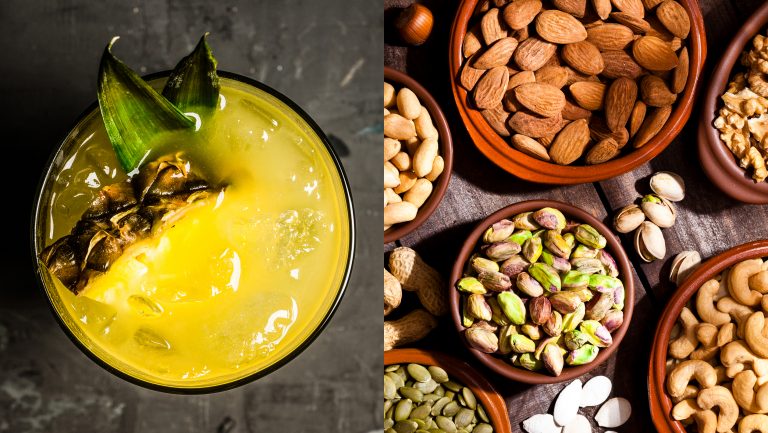Orgeat is the classic French almond syrup that’s famously used to flavor the Mai Tai. In recent years bartenders have been messing with the standard recipe (almonds, sugar, water, orange-flower water), making the syrup with other nuts, seeds, and ingredients that stray ever further from the original.
But what we tend to think of as “authentic” orgeat today isn’t like the original recipe—the word orgeat derives from the French and Latin term for “barley”; it referred to a barley-water beverage. The original barley recipe evolved into orgeat syrup in French-speaking countries—and into various forms of horchata in Spanish-speaking ones.
Throughout the U.S., bartenders have further developed the recipe for the syrup. The most common orgeat spin-offs involve nuts other than almonds. A few examples are the peanut orgeat at Spoonbar in Healdsburg, California; the macadamia nut orgeat at Orchard City Kitchen in Campbell, California; the walnut orgeat at KYU in Miami; the pistachio orgeat at Nico Osteria in Chicago; and the pecan orgeat at Midnight Rambler in Dallas.

Don’t miss the latest drinks industry news and insights. Sign up for our award-winning newsletters and get insider intel, resources, and trends delivered to your inbox every week.
Several bars are swapping out nuts altogether for seeds. Adam Robinson of the forthcoming Deadshot in Portland, Oregon, makes an orgeat with toasted sesame seeds and uses it in a cocktail with bourbon, sherry, lemon, mustard, and egg yolk. “It’s bizarre,” he says, “and delicious.”
At Pacific Cocktail Haven in San Francisco, Kevin Diedrich’s menu is full of tropical-style cocktails that have included a variety of orgeats, including those made with almond, walnut, and macadamia nuts and roasted pepitas (pumpkin seeds) and sunflower seeds. “Replacing almond [in] orgeat with other nuts opens up a new whole flavor profile for classic cocktails,” says Diedrich.”The spectrum is endless.” He suggests starting with a Mai Tai or the Japanese Cocktail, and experimenting with different types of orgeats.
Bartenders at Paper Plane in San Jose, California, make a coconut orgeat from both toasted coconut and coconut water. While their recipe calls for orange-flower water, they frequently omit this aromatic ingredient. Other bars are experimenting with additional flavors, sometimes replacing the orange-flower water with other aromatic ingredients. Mourad restaurant in San Francisco has offered a pecan orgeat flavored with clove and harissa, while New York’s Clover Club serves an orgeat smoked with palo santo wood in its Wooden Saint cocktail with white rum, sherry, lemon, and demerara. Eden Laurin, a managing partner at One Off Hospitality in Chicago, says, “This summer, Dove’s Luncheonette will feature a lavender orgeat on the menu. We were inspired by the lavender almonds we had at our sister restaurant, Avec.”
Some bars are also replacing the usual water with other liquids. The coconut water in Paper Plane’s orgeat is one example, but Trick Dog in San Francisco also created a “carrot orgeat” by replacing the water with carrot juice.
Other recipes stray even further afield. Morgan Anders of Rob Roy in Seattle will soon be putting a cocktail with fried plantain orgeat on the bar’s menu. “It has a lot of the same characteristics of traditional almond orgeat,” he says. “The silky texture, the light fragrance—but it’s made with fried plantains instead.” Kelsey Ramage and Iain Griffiths of the roving sustainability cocktail party Trash Tiki have homed in on the avocado as a sustainable base ingredient; their recipe for avocado pit orgeat, made from food waste, is posted on their site.
And finally, one bar is putting the grains back into orgeat. At The Spotted Owl in Cleveland, Will Hollingsworth makes an orgeat from sushi rice and another from toasted red quinoa. “Our red quinoa and sushi rice orgeats were both split with almond because I think the fattiness is crucial,” he says. “Using almonds as a base gives us those base nutty and fatty notes, but the addition of toasted starchy grains adds depth and heft and, honestly, makes the almonds taste nuttier.”
So if orgeat is no longer just an almond syrup and is increasingly beginning to include seeds, pits, or grains, as well as a number of nontraditional flavorings, do we need a new definition for it? Hollingsworth thinks so. He recalls recently suggesting that a bartender add some pistachio orgeat to a recipe to give the cocktail some heft, but he says, “[The bartender] called me and said, ‘Hey, I’m looking through our master prep list, and there’s a recipe here for pistachio syrup but not for pistachio orgeat. Are they the same thing?’ My answer was, ‘We basically use the word orgeat to describe any fatty syrup.’”
As that definition seems to apply to all the orgeats described above, it seems like a good working catch-all definition for this ever-changing cocktail ingredient.

Dispatch
Sign up for our award-winning newsletter
Don’t miss the latest drinks industry news and insights—delivered to your inbox every week.
Camper English is an international cocktails and spirits writer, speaker, and consultant, with a focus on the science of booze and big clear ice. His work has appeared in Popular Science, Cook’s Science, Whisky Advocate, Saveur, Details, the San Francisco Chronicle, and many other publications.







